|
FEATURE
STORIES
TOKYO
Musée Tomo
Modern Ceramics
Toranomon, Tokyo
Mingeikan
Japan Folk Crafts Museum, Tokyo  |
|
Return to Tokyo Museums Top Menu
|
FEATURE STORY
Nippon Mingeikan
Japan Folk Crafts Museum
TEL: (03) 3467-4527
Click here for directions
MINGEIKAN'S OWN WEB SITE
The Japan Folk Crafts Musuem in Tokyo
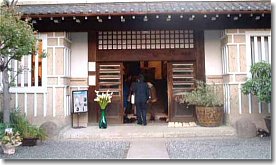 |
On a quiet side street in the Tokyo district of Komaba is the Japan Folk Crafts Museum known as the Nippon Mingeikan.
It stands out in stark contrast to the surrounding newer buildings with its warmth and traditional architecture; it is one of Japan's treasures in its own right. The doors to this wooden structure first swung open on October 24, 1936, thanks to the visionary ideals of
Muneyoshi (Soetsu) Yanagi - 1889-1961. He writes of the museum, "The name is not mere words; it stands for the arts of the people, returned to the people."
Many know the story of
Mingei, but for those who do not I highly recommend Mingei - Masterpieces of Japanese Folkcraft and Yanagi's The Unknown Craftsman, both published by Kodansha International. I will leave the philosophy and story to Yanagi; I'd like to focus this brief article on the museum itself.
For me it is always a pilgrimage going there. The beauty and serenity of the stone, stucco, and wooden structure alone is a breath of fresh air as one leaves the hubbub of Shibuya behind. Yanagi designed the whole structure. Across the street from the main building is Yanagi's old residence with its commanding nagayamon (long-gate house) now designated as a Cultural Asset of Tokyo.
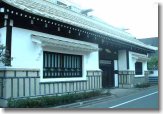 |
Too bad some modern architect - the guy who did Kyoto station - dreamt up the monstrosity that now looms over these two quaint and important structures. So be it, it takes away from the ambience of the area but it will never take away from the elegance and charm of the Mingeikan. Yet, it's not easy being the Mingeikan these days!
Compared to other museums, attendance is relatively small, only about thirty thousand visitors per year. About 20% of those "pilgrims" are gaijin, or foreigners. It is a crying shame that so many Japanese don't even know of the place, and more importantly the purpose of its existence in the first place.
Yet, there is a strong following and they heeded the call for donations to renovate the buildings, which started at the end of last year (2001). The museum was closed until April 9, 2002 (more about its recent opening later).
The nagayamon was outfitted with a new sixty-ton roof made exclusively of a special stone called oyaishi. It is quarried not far from
Mashiko and can be found on the exterior of the main building as well. Only two living craftsman had the skills to redo the roof and it took much persuading by the Mingeikan staff to bring them to Tokyo. They got the job done, of course, and trained younger workers in the process; that is another important aspect of the mingei philosophy - pass it on. The staff told me that the old roof's wooden-support structure was so rotten it was a small miracle it stood as long as it had. Knock on tatami for that.
The work in the main building was not as superficially noticeable. There was all the fresh wallpaper made of kuzu (Japanese arrowroot) giving the rooms a lighter air.
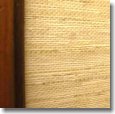 |
The old wallpaper had many stains from water leakage and when dignitaries visited, like the Crown Prince, the staff moved the display cases to conceal the water spots! No need for that anymore, thank goodness.
The main work was under the floors, in the ceiling, and for the storage of their vast collection they made the whole structure semi-earthquake proof.
To celebrate the reopening of the Minkeikan on April 9th, a Edo-Period style fire brigade was called in and they performed a chant-like song that was quite hypnotizing.
It was a safety and congratulatory song that started at the main entrance and led up the stairs to the main hall. In the hall one of the firemen used his matoi (brigade's code-of-arms pole), which was used in the Edo period to show which brigade put out the fires, but is now used as another festive tool.
After that it was a loud cracking of a vat of sake and a hearty kampai (cheers, down the hatch) by the few hundred people in attendance. Amongst those were Living National Treasure Shimaoka Tatsuzo and Takita Koichi, another wonderful mingei potter.
Yet, the Mingeikan is still way short of the one and a half million dollars needed to continue and to cover expenses already incurred.
They are asking for donations in any amount and would be greatly appreciative of anything sent from overseas. You can contact the museum by phone directly to inquire, or send your inquiries to Robert at e-y net and he will assist with the transfer.
The museum is now holding a special exhibit of works all selected by Yanagi himself, including scrolls, paintings, lacquer, textiles, metal works, and pottery from Japan, China, and Korea. See below photos.
|
Lacquer
|
|
|
Chinese
Ming Plate
Sennin
|
|
|
Japanese
Pieces
|
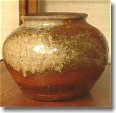 
|
|
Korean Pots
Korean Room
|
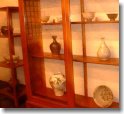 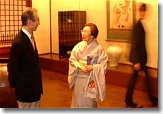
|
|
Textiles
|
|
|
In general, four exhibits are held each year (this particular exhibit ends on June 30). Part two of the collection, focusing on Western art, will be shown next, from July 9 to Sept. 23, followed by a major exhibition of Munakata Shiko from Oct.1 until Dec.20, and that is how this year will end.
 On behalf of the staff of the Mingeikan, and director Yanagi Sori, I ask for your support, a visit there if you're ever in this neck of the bamboo forest, and a quiet pondering on the thoughts and ideas of Yanagi. His vision is universal, and one that tries to bring wholesome beauty into our everyday life. On behalf of the staff of the Mingeikan, and director Yanagi Sori, I ask for your support, a visit there if you're ever in this neck of the bamboo forest, and a quiet pondering on the thoughts and ideas of Yanagi. His vision is universal, and one that tries to bring wholesome beauty into our everyday life.
DIRECTIONS
To get to the Mingeikan, (03) 3467-4527, take the Inokashira Line from Shibuya Station (make sure not to get on an express) and get off at the second stop, Komaba-Todaimae. Walk out of the station and under the tracks and turn left. Follow that road until it curves to the right, about a seven-minute walk. The Mingeikan will be on your right. Admission 1,000 yen, college/high school students 500 yen, and middle school and elementary school students 200 yen. Open daily except Mondays 10 a.m.-5 p.m.
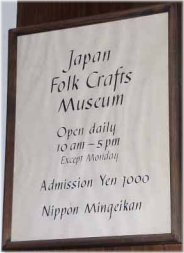 |
Article by Robert Yellin
Muneyoshi (Soetsu) Yanagi - 1889-1961
www.e-yakimono.net/guide/html/mingei.html
MINGEIKAN'S OWN WEB SITE
The Japan Folk Crafts Musuem in Tokyo
|
|
|